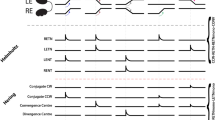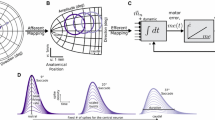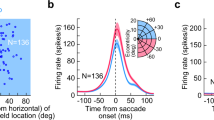Summary
(1) Discharge characteristics of neurons in the region of the interstitial nucleus of Cajal (INC) were studied in alert cats during spontaneous or visually induced eye movement and sinusoidal vertical (pitch) rotation. Activity of a majority of cells (n = 68) was closely related to vertical eye position with or without bursting activity during on-direction saccades. They were called vertical burst-tonic (n = 62) and tonic (n = 6) neurons. Mean discharge rates for individual cells when the eye was near the primary position ranged from 35 to 133 (mean 75) spikes/s with a coefficient of variation (CV) ranging from 0.04 to 0.29 (mean 0.15). Average rate position curves were linear for the great majority of these cells with a mean slope of 3.9 ± 1.2 SD spikes/s/deg. (2) The burst index was defined as the difference in discharge rate between maximal rate during an on-direction saccade and the tonic rate after the saccade. The values of mean burst index for individual cells ranged from 8 to 352 (mean 135) spikes/s. Tonic neurons had a burst index lower than 60 spikes/s and were distributed in the lower end of the continuous histogram, suggesting that burst-tonic and tonic neurons may be a continuous group with varying degrees of burst components. During off-direction saccades, a pause was not always observed, although discharge rate consistently decreased and pauses were seen when saccades were made further in the off-direction toward recruitment thresholds. Significant positive correlation was observed between average discharge rate during off- as well as on-direction saccades and tonic discharge rate after saccades for individual cells, which was not due to cats making saccades mainly from the primary position. (3) During pitch rotation at 0.11 Hz (±10 deg), burst-tonic and tonic neurons had mean phase lag and gain of 128 (±13 SD) deg and 4.2 (±1.7 SD) spikes/s/deg/s2 relative to head acceleration. During pitch rotation of a wide frequency range (0.044–0.495 Hz), the values of phase lag were mostly constant (120–140 deg), while simultaneously recorded vertical VOR showed the mean phase lag of 178 deg. Vertical eye position sensitivity and pitch gain (re head position) showed significant positive correlation. (4) Comparison of the discharge characteristics of vertical burst-tonic and tonic neurons with those of secondary vestibulo-ocular neurons (Perlmutter et al. 1988) and extraocular motoneurons (Delgado-Garcia et al. 1986) in alert cats suggests that signals carried by burst-tonic and tonic neurons are partially processed signals in vertical VOR and saccades, and different from oculomotor signals. (5) The INC region also contained many cells that did not belong to the above groups but whose activity was clearly modulated by pitch rotation (called pitch cells for the present study, n = 44). Many (n = 23) showed some correlation with vestibular quick phases, and some (n = 12) with visually elicited eye movement, although they showed significantly lower and more irregular discharge rates than burst-tonic and tonic neurons (mean discharge rate when the eye was near the primary position 34, range 3–91, spikes/s; mean CV 0.61, range 0.15–1.7). During pitch rotation they showed the mean phase lag and gain of 119(±26 SD) deg and 3.2(±2.1 SD) spikes/s/deg/s2. Some cells showed a much lower phase lag of about 90 deg. (6) More than half the burst-tonic, tonic and pitch cells tested were antidromically activated by stimuli applied to the ponto-medullary medial longitudinal fasciculus at the level of abducens nucleus, while none of them were activated from the inferior olive, suggesting that vertical eye position signals carried by some burst-tonic and tonic neurons are carried to the lower brainstem.
Similar content being viewed by others
References
Anderson JH (1981) Behavior of the vertical canal VOR in normal and INC-lesioned cats. In: Fuchs AF, Becker W (eds) Progress of oculomotor research: developments in neuroscience, Vol 12. Elsevier/North-Holland, pp 395–401
Anderson JH, Precht W, Papas C (1979) Changes in the vertical vestibulo-ocular reflex due to kainic acid lesions of the interstitial nucleus of Cajal. Neurosci Lett 14:259–264
Barmack NH, Hess DT (1980) Multiple-unit activity evoked in dorsal cap of inferior olive of the rabbit by visual stimulation. J Neurophysiol 43:151–164
Berman AL (1968) The brainstem of the cat: a cytoarchitectonic atlas with stereotaxic coordinates. The University of Wisconsin Press, Madison Milwaukee London, pp 26–38
Büttner U, Büttner-Ennever JA, Henn V (1977) Vertical eye movement related unit activity in the rostral mesencephalic reticular formation of the alert monkey. Brain Res 130:239–252
Cannon SC, Robinson DA (1987) Loss of the neural integrator of the oculomotor system from brain stem lesions in monkey. J Neurophysiol 57:1383–1409
Carpenter MB, Harbison JW, Peter P (1970) Accessory oculomotor nuclei in the monkey: projections and effects of discrete lesions. J Comp Neurol 140:131–154
Chubb MC, Fuchs AF (1982) Contribution of y group of vestibular nuclei and dentate nucleus of cerebellum to generation of vertical smooth eye movements. J Neurophysiol 48:75–99
Chubb MC, Fuchs AF, Scudder CA (1984) Neuron activity in monkey vestibular nuclei during vertical vestibular stimulation and eye movements. J Neurophysiol 52:724–742
Crawford D, Cadera W, Vilis T (1988) The coulomotor velocity to position transformation involves the nucleus of Cajal. Ann Meeting Soc Neurosci 14:956 (Abstr)
De la Cruz RR, Escudero M, Delgado-Garcia JM (1989) Behaviour of medial rectus motoneurons in the alert cat. Eur J Neurosci (in press)
Delgado-Garcia JM, Del Pozo F, Baker R (1986) Behavior of neurons in the abducens nucleus of the alert cat. 1. Motoneurons. Neuroscience 17:929–952
Delgado-Garcia JM, Vidal PP, Gomez C, Berthoz A (1988) Vertical eye movements related signals in antidromically identified medullary reticular formation neurons in the alert cat. Exp Brain Res 70:585–589
Delgado-Garcia JM, Vidal PP, Gomez C, Berthoz A (1989) A neurophysiological study of prepositus hypoglossi neurons projecting to oculomotor and preoculomotor nuclei in the alert cat. Neuroscience 29:291–307
Evinger LC, Fuchs AF, Baker R (1977) Bilateral lesions of the medial longitudinal fasiculus in monkeys: effects on the horizontal and vertical components of voluntary and vestibular induced eye movements. Exp Brain Res 28:1–20
Fuchs AF, Luschei ES (1970) Firing patterns of abducens neurons of alert monkeys in relationship to horizontal eye movement. J Neurophysiol 33:382–392
Fuchs AF, Kaneko CRS, Scudder CA (1985) Brainstem control of saccadic eye movements. Ann Rev Neurosci 8:307–337
Fuchs AF, Scudder A, Kaneko CRS (1988) Discharge patterns and recruitment order of identified motoneurons and internuclear neurons in the monkey abducens nucleus. J Neurophysiol 60:1874–1895
Fukushima K (1987) The interstitial nucleus of Cajal and its role in the control of movements of head and eyes. Prog Neurobiol 29:107–192
Fukushima K, Murakami S, Matsushima J, Kato M (1980) Vestibular responses and branching of interstitiospinal neurons. Exp Brain Res 40:131–145
Fukushima K, Ohno M, Takahashi K, Kato M (1982) Location and vestibular responses of interstitial and midbrain reticular neurons that project to the vestibular nuclei in the cat. Exp Brain Res 45:303–312
Fukushima K, Kudo J, Takahashi K, Kato M (1985) Effects of lesion of the interstitial nucleus of Cajal on vestibular horizontal canal neurons in the cat. Neurosci Res 2:287–294
Fukushima K, Takahashi K, Fukushima J, Ohno M, Kimura T, Kato M (1986) Effects of lesion of the interstitial nucleus of Cajal on vestibular nuclear neurons activated by vertical vestibular stimulation. Exp Brain Res 64:496–504
Fukushima K, Fukushima J, Terashima T (1987a) The pathways responsible for the characteristic head posture produced by lesions of the interstitial nucleus of Cajal in the cat. Exp Brain Res 68:88–102
Fukushima K, Fukushima J, Ohashi T, Suzuki Y, Ohno M, Kato M (1987b) Adaptive changes of vertical vestibuloocular reflex (VOR) induced by tenectomy of vertical recti muscles in cats. Neuroscience Suppl (Abstr) 22:S735
Fukushima K, Fukushima J, Ohashi T, Suzuki Y, Kase M (1989a) Adaptive change of vertical vestibulo-ocular reflex induced by tenectomy of vertical recti muscles and neuronal behavior related to vertical eye movement in the region of the interstitial nucleus of Cajal in alert cats. Brain Behav Evol 33:356–364
Fukushima K, Harada C, Fukushima J, Suzuki Y (1990) Spatial properties of vertical eye movement-related neurons in the region of the interstitial nucleus of Cajal in awake cats. Exp Brain Res 79:25–42
Fukushima K, Fukushima J (1990) Involvement of the interstitial nucleus of Cajal in the midbrain reticular formation in position-related, tonic component of vertical eye movement and head posture. In: Berthoz A, Graf W, Vidal PP (eds) Head neck sensory motor system volume. John Wiley & Sons, West Sussex (in press)
Fukushima-Kudo J, Fukushima K, Tashiro K (1987) Rigidity and dorsiflexion of the neck in progressive supranuclear palsy and the interstitial nucleus of Cajal. J Neurol Neurosurg Psychiatr 50:1197–1203
Golberg JM, Fernandez C (1971) Physiology of peripheral neurons innervating semicircular canals of the squirrel monkey. III. Variation among units in their discharge properties. J Neurophysiol 34:676–684
Graf W, McCrea RA, Baker R (1983) Morphology of posterior canal related second order vestibular neurons in rabbit and cat. Exp Brain Res 52:125–135
Graf W, Ezure K (1986) Morphology of vertical canal related second order vestibular neurons in the cat. Exp Brain Res 63:35–48
Highstein SM, Moschovakis AK, Warren JD (1986) Morphology of vertical medium lead burst neuron in the alert squirrel monkey. Ann Meeting Soc Neurosci 12:1186 (Abstr)
Hikosaka O, Kawakami T (1977) Inhibitory reticular neurons related to the quick phase of vestibular nystagmus: their location and projection. Exp Brain Res 27:377–396
Kaneko CRS, Evinger C, Fuchs AF (1981) Role of cat pontine burst neurons in generation of saccadic eye movements. J Neurophysiol 46:387–408
Kaneko CRS (1986) Location and discharge of saccade-related neurons in alert cat and monkey: developments in oculomotor research. Satellite meeting International Union of Physiological Sciences Abstr p 78
Keller EL (1974) Participation of medial pontine reticular formation in eye movement generation in monkey. J Neurophysiol 37:316–332
King WM, Fuchs AF (1979) Reticular control of vertical saccadic eye movements by mesencephalic burst neurons. J Neurophysiol 42:861–876
King WM, Leigh RJ (1982) Physiology of vertical gaze. In: Lennerstrand G, Zee DS, Keller EL (eds) Functional basis of ocular motility disorders. Pergamon, Oxford New York Frankfurt, pp 267–276
King WM, Lisberger SG, Fuchs AF (1976) Responses of fibers in medial longitudinal fasciculus (MLF) of alert monkeys during horizontal and vertical conjugate eye movements evoked by vestibular or visual stimuli. J Neurophysiol 39:1135–1149
King WM, Precht W, Dieringer N (1980) Synaptic organization of frontal eye fields and vestibular afferents to interstitial nucleus of Cajal in the cat. J Neurophysiol 43:912–928
King WM, Fuchs AF, Magnin M (1981) Vertical eye movement-related responses of neurons in midbrain near interstitial nucleus of Cajal. J Neurophysiol 46:549–562
Lisberger SG, Pavelko TA (1986) Vestibular signals carried by pathways subserving plasticity of the vestibulo-ocular reflex in monkeys. J Neurosci 6:346–354
Lopez-Barneo J, Darlot C, Berthoz A, Baker R (1982) Neuronal activity in prepositus nucleus correlated with eye movement in the alert cat. J Neurophysiol 47:329–352
Louie AW, Kimm J (1976) The response of 8th nerve fibers to horizontal sinusoidal oscillation in the alert monkey. Exp Brain Res 24:447–457
Luschei ES, Fuchs AF (1972) Activity of brainstem neurons during eye movements of alert monkeys. J Neurophysiol 35:445–461
McCrea RA, Strassman A, Highstein SM (1987) Anatomical and physiological characteristics of vestibular neurons mediating the vertical vestibulo-ocular reflexes of the squirrel monkey. J Comp Neurol 264:571–194
Nakao S, Shiraishi Y (1985) Direct excitatory and inhibitory synaptic inputs from the medial mesodiencephalic junction to motoneurons innervating extraocular oblique muscles in the cat. Exp Brain Res 61:62–72
Nakao S, Shiraishi Y, Oikawa T (1986) Vertical eye movement-related neurons in the medial mesodiencephalic junction: their firing patterns, location and projection to oculomotor and trochlear nuclei. Neurosci Res Suppl (Abstr) 3:S66
Nakao S, Shiraishi Y, Oda H, Inagaki M (1988) Direct inhibitory projection of pontine omnipause neurons to burst neurons in the Forel's field H controlling vertical eye movement-related motoneurons in the cat. Exp Brain Res 70:632–636
Onodera S (1984) Olivary projections from the mesodiencephalic structures in the cat studied by means of axonal transport of horseradish peroxidase and tritiated amino acids. J Comp Neurol 227:37–49
Perlmutter SI, Fukushima K, Peterson BW, Baker JF (1988) Spatial properties of second order vestibuloocular relay neurons in the alert cat. Ann Meeting Soc Neurosci 14:331 (Abstr)
Pola J, Robinson DA (1978) Oculomotor signals in medial longitudinal fasciculus of the monkey. J Neurophysiol 41:245–259
Robinson DA (1970) Oculomotor unit behavior in the monkey. J Neurophysiol 33:393–404
Robinson DA (1981) Control of eye movements. In: Brookhart JM, Mountcastle VB (eds) Handbook of physiology, Vol 2, Part 2. American Physiological Society, Bethesda Maryland, pp 1275–1320
Schwindt PC, Precht W, Richter A (1974) Monosynaptic excitatory and inhibitory pathways from medial midbrain nuclei to trochlear motoneurons. Exp Brain Res 20:223–238
Spence SJ, Saint-Cyr JA (1988a) Mesodiencephalic projections to the vestibular complex in the cat. J Comp Neurol 268:375–388
Spence SJ, Saint-Cyr JA (1988b) Comparative topography of projections from the mesodiencephalic junction to the inferior olive, vestibular nuclei, and upper cervical cord in the cat. J Comp Neurol 268:357–374
Tomlinson RD, Robinson DA (1984) Signals in vestibular nucleus mediating vertical eye movements in the monkey. J Neurophysiol 51:1121–1136
Yoshida K, Berthoz A, Vidal PP, McCrea R (1981) Eye-movement related activity of identified second order vestibular neurons in the cat. In: Fuchs AF and Becker W (eds) Progress in oculomotor research: developments in neuroscience, Vol 12. Elsevier/North-Holland, pp 371–378
Zuk A, Rutherford JD, Gwyn DG (1983) Projections from the interstitial nucleus of Cajal to the inferior olive and to the spinal cord in cat: a retrograde fluorescent double-labeling study. Neurosci Lett 38:94–101
Author information
Authors and Affiliations
Rights and permissions
About this article
Cite this article
Fukushima, K., Fukushima, J., Harada, C. et al. Neuronal activity related to vertical eye movement in the region of the interstitial nucleus of Cajal in alert cats. Exp Brain Res 79, 43–64 (1990). https://doi.org/10.1007/BF00228872
Received:
Accepted:
Issue Date:
DOI: https://doi.org/10.1007/BF00228872




